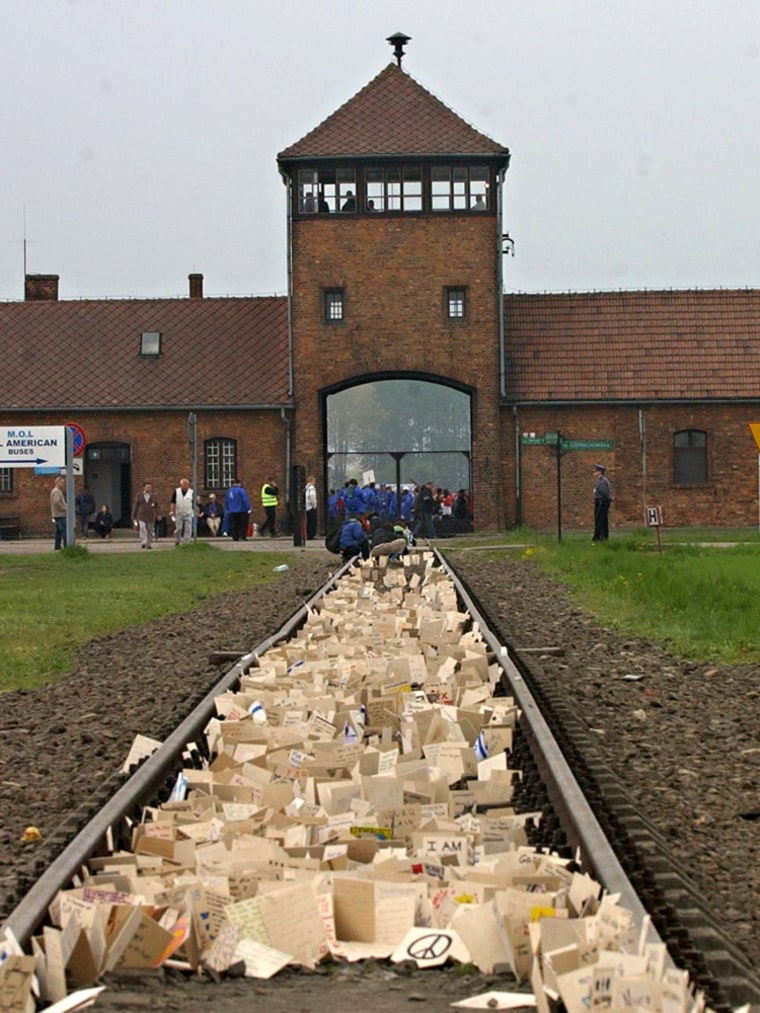Some 10,000 young Jews, Poles and World War II survivors took part in the March of the Living on Thursday, an annual event at the former Nazi death camp of Auschwitz-Birkenau that honors the memory of some 6 million Jews who perished in the Holocaust.
This year's march, the 17th, started with the blowing of the shofar, or ram's horn, at the iron gate — crowned with the words "Arbeit Macht Frei," or "Work Sets You Free" — that leads into the former camp of Auschwitz.
The misleading inscription was to suggest to inmates they were coming to work, not die here.
The Israeli army chief of staff, Lt. Gen. Gabi Ashkenazi, led the long column of marchers, accompanied by some camp survivors carrying the Torah and fellow Israeli troops in uniform.
"Each and every one of us should do our utmost to ensure: Never again," Ashkenazi said.
The Kaddish — the Jewish prayer for the dead — was spoken at a huge stone monument to the camp's victims at Birkenau.
At least 1.1 million people, including Jews, Poles and Roma, perished in the camp's gas chambers or from starvation, disease and forced labor before Soviet troops liberated it in January 1945.
Israel also held observances in memory of Jews killed in the Nazi Holocaust, with sirens wailing and traffic halting for two minutes across the country.
Marchers from 50 countries
In Poland marchers from some 50 countries in matching raincoats formed a sea of blue, with Israeli white-and-blue national flags fluttering overhead. There was an occasional drizzle as they walked in Oswiecim, the Polish city where the occupying Germans built the complex.
They walked in silence along a 2-mile stretch from the red brick houses of Auschwitz to Birkenau, another area of the camp that is the site of wooden barracks and ruins of the gas chambers.
Survivor Leib Zisman was visiting Birkenau for the first time since January 1945, when the Nazis forced the inmates to walk out of the camp in frost and snow to flee the advancing Soviet army.
"I walked into the barracks in Birkenau and I recognized the beds that I slept in," said Zisman, 77, of Long Island, N.Y. "The memories are very vivid; I remember everything."
The then 13-year-old Zisman was brought to Birkenau in 1944 from the Kovno ghetto in Lithuania, where his parents died. From Birkenau, he was taken to camps in Germany, where he was liberated by U.S. troops.
"It's really emotional and I can only say I am sad that I haven't come here sooner, but I wasn't ready," he said.
Among the marchers was Avram Grant, the Israeli manager of English soccer club Chelsea. It was his seventh visit to Auschwitz. This time, he brought his 14-year-old son, Daniel, and wife, Tsofit. His Polish-born father survived the Holocaust, but many other members of his family were killed.
"It was terrible how people behaved to other people," Grant said. "It is good that they kept a place like this as a memory and as education that to hate someone is not the right way."
Teenage participants also stressed the power of remembering.
"The most amazing feeling of the march is togetherness," said Elana Weiner, a 17-year-old student from Tucson, Ariz. "We are the key to the future and if we remember and promise to never forget, then the rest of the world won't."
